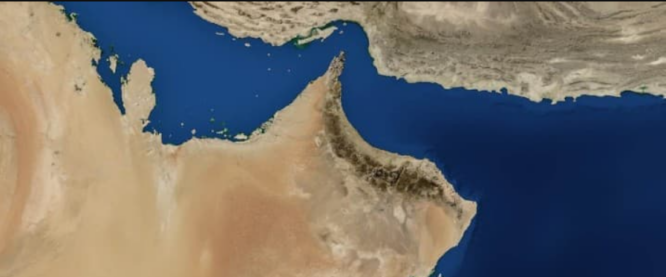
After Russia’s invasion of Ukraine last year, it would be naïve to think that Iran’s seizure of oil ships in its coastal waters occurred in political isolation. They did not, and Middle Eastern vessel seizures and other oil market disruptions will continue.
My new book analyzes the new global oil market order, including this. The oil tanker Advantage Sweet was seized by Iran’s Islamic Revolutionary Guard Corps Navy (IRGCN) on Thursday, April 27. The tanker carried 800,000 barrels of Iraqi Ratawi crude oil for Chevron at Kuwait’s Mina Saud port on April 25.
A few days later, on Wednesday 3 May, the same Iranian naval troops detained another oil tanker, the Niovi, when it departed Dubai towards Fujairah, also in the UAE, via the Strait of Hormuz. Iran claims that this second seizure was related to a 2020 legal dispute between Nimr International and Baslam Nakliyat and Marshall Islands-based La Mere Maritime, however, both seizures followed a U.S. incident.

The U.S. moved China’s Iranian crude oil vessel Suez Rajan, breaching sanctions.
According to a source who works closely with the European Union’s (EU) energy security apparatus and another with close ties to Iran’s Petroleum Ministry, both spoken to exclusively by OilPrice.com last week, China’s tacit support to Iran allowed the IRGCN to seize the two oil tankers.
“China wants to lay down a clear marker that it will not tolerate U.S. interference in any of its dealings with its major Middle Eastern allies, and Iran is at the top of this list, and this includes any U.S. interference in oil flows from Iran to China,” said the Iranian source.
“China does not recognize the unipolar geopolitical economic order with Washington at the center that the U.S. continues to try to impose on other countries,” he said. “China has the legal foundation to conduct such [oil] trade under the 25-year agreement made with Iran and has the right under the same agreement to protect its interests, regardless of arbitrary unilateral sanctions [on Iran] imposed by the U.S.,” he concluded.
China has broad access to Iran’s energy, economic, and military sectors under the “Iran-China 25-Year Comprehensive Cooperation Agreement,” first revealed worldwide in my 3 September 2019 article and fully examined in my new book on the new global oil market order. China wrote several military cooperation policies into the Agreement, including first refusal on all Iranian oil and gas fields and huge discounts on their output.
One was the annual exchange of dozens of top officers of the two nations’ fleets, armies, air forces, intelligence organizations, and technical specialists connected to special projects. China also received “dual purpose” military and civilian rights to use Iranian military and civilian installations for its navy and air force.
China’s IRGCN oil ship seizures set a clear precedent, even if no Chinese military forces were engaged. It shows that China will not tolerate U.S. involvement in its Middle East ambitions or its oil and gas flows. It also shows that China may disrupt global oil flows through Iran and Saudi Arabia, as I discuss in my forthcoming book on the new global oil market order. These two oil ship seizures show that Iran now controls the Strait of Hormuz for China.

The Gulf of Oman oil ship seizure last week was not an isolated incident.
The Strait transports at least 30% of the world’s crude oil, often more. The same 25-year Agreement grants China control over the Bab al-Mandab Strait, where crude oil is carried from the Red Sea to the Suez Canal, the Mediterranean, and westward. It is between Yemen, once controlled by Iran-backed Houthis, and Djibouti, which China has strangled. The Advantage Sweet’s capture also proves that oil tankers cannot use the Gulf of Oman safely.
These latest Iranian seizures, which China is using to show that it will no longer tolerate U.S. interference in its affairs, also show that China does not see any immediate financial or economic fallout from higher oil prices due to a higher risk premium. China receives Iranian oil and gas at least 30% below benchmark rates under the 25-Year Agreement.
According to the EU energy security source, since Russia invaded Ukraine in February 2022, China has demanded an additional discount on Iranian oil to the 30% discount it can already buy Russian oil. He claimed the Chinese discount for Iranian crude oil to the international benchmark has averaged 44% over the past year.
“But, it is even worse for Iran, as – from 11 November 2022 – China has been paying Iran in non-convertible Yuan, which can only be used inside China and/or spent buying Chinese goods,” he said. “Worse still is that whilst Yuan is the key instrument in payment, China is also using the currencies of Angola, Zambia, and Kenya to pay Iran, and China is doing this to induce Iran to buys goods from these countries so that these countries, in turn, can service their loans to China,” he concluded.
Finally, China looks to be ready to reveal its Iranian crude oil purchases. As I discuss in my new book on the new global oil market order, China previously hid its massive Iranian oil purchases. Iranian oil being “rebranded” as non-Iraqi oil at source, a tried-and-true procedure. The two nations share large oil reserves, making this easy. Disabling the “automatic identification system” on Iranian oil-carrying ships with a switch has been done at sea with oil cargoes already in motion.
Lie about provenance, destinations, or cargo kinds on shipping papers. In 2020, former Petroleum Minister Bijan Zanganeh stated, “What we export is not under Iran’s name. Documents and specifications change frequently.” In addition, ships going for China would shift Iranian oil onto tankers flying different colors at sea or just outside port. “If there is an art that we have perfected in Iran, [that] we can teach to others for a price, it is the art of evading sanctions,” Iran’s Foreign Minister Mohammad Zarif said at the Doha Forum in December 2018. China no longer wants to appease the U.S.
